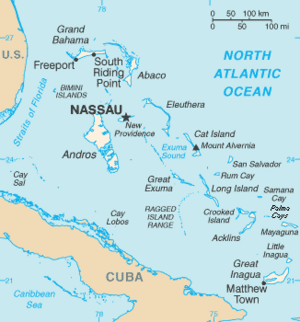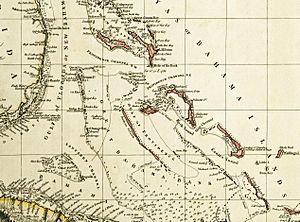Capture of the Bahamas (1782) facts for kids
Quick facts for kids Capture of the Bahamas |
|||||||
|---|---|---|---|---|---|---|---|
| Part of the American Revolutionary War | |||||||
 Map of the Bahamas |
|||||||
|
|||||||
| Belligerents | |||||||
| Commanders and leaders | |||||||
| Strength | |||||||
| 23 ships 1,400+ |
59 ships 1,500 sailors 1,588 regulars 50 light infantry 202 militia |
||||||
| Casualties and losses | |||||||
| 1,412 captured 77 merchant ships captured 1 frigate captured 4 brigantines captured 5 schooners captured 2 sloops captured 11 privateer ships captured |
none | ||||||
The Capture of the Bahamas happened in May 1782. It was part of the American Revolutionary War. A Spanish force, led by Juan Manuel Cagigal, arrived at New Providence island. This island is home to Nassau, the capital of the Bahamas. The British commander in Nassau, John Maxwell, decided to give up the island. He surrendered without a fight because the Spanish force was much stronger.
Why Did Spain Attack the Bahamas?
Spain joined the American War of Independence in 1779. They wanted to push the British out of the Gulf of Mexico. Spain had already taken British areas like West Florida, including Mobile and Pensacola.
A Spanish leader named Bernardo de Gálvez planned to attack Nassau. Nassau was important to the British. It was a main base for their privateering ships. Privateering meant private ships were allowed to attack enemy ships.
Gálvez planned the attack in late 1781. But it was put on hold because of the Siege of Yorktown. This siege led to a big British army surrendering in October 1781. In early 1782, the plan was brought back. Command of the mission was given to Juan Cagigal, who was the Governor of Havana.
How the Capture Happened
Juan Cagigal decided to go ahead with the plan. He sailed from Havana on April 18, 1782. This was even though Gálvez had told him to stop the mission. Gálvez wanted Cagigal's troops for a planned invasion of Jamaica.
Cagigal had about 2,500 soldiers. He also got more ships from the South Carolina Navy. These ships were led by Alexander Gillon.
On May 6, Cagigal's ships appeared near Nassau. He convinced the British commander, Vice Admiral John Maxwell, to surrender. Maxwell gave up without a long fight or a siege of the town. A siege is when an army surrounds a place to cut off supplies and force a surrender.
Maxwell offered 12 conditions for surrender. Cagigal made a few small changes and then accepted. Spanish forces then took over Nassau. They captured the 600 British soldiers there. They also took several British ships, including a frigate (a type of warship).
What Happened Next?
Gálvez was not happy that Cagigal had ignored his orders. He was also upset because a British naval victory had stopped his plan to invade Jamaica. Gálvez arranged for Cagigal to be arrested. This was for how he treated a British general after the Siege of Pensacola. Cagigal was put in prison in Cadiz, Spain. This ended his military career.
One of Cagigal's friends, Francisco de Miranda, also faced similar problems. This might have made him want to fight for independence for Spain's American colonies later on. In the end, Gálvez got the credit for capturing the Bahamas. This was even though he had tried to cancel the mission.
Later, an American Loyalist named Andrew Deveaux decided to recapture Nassau. Loyalists were American colonists who stayed loyal to Britain. He succeeded on April 17, 1783. He had only 220 men and 150 muskets. He faced 600 trained Spanish soldiers.
However, by this time, a peace treaty was being made. The Treaty of Paris (1783) ended the American Revolutionary War. In this treaty, Spain gave the Bahamas back to Britain. In return, Britain gave East Florida to Spain.
See also
 In Spanish: Conquista española de las Bahamas para niños
In Spanish: Conquista española de las Bahamas para niños


